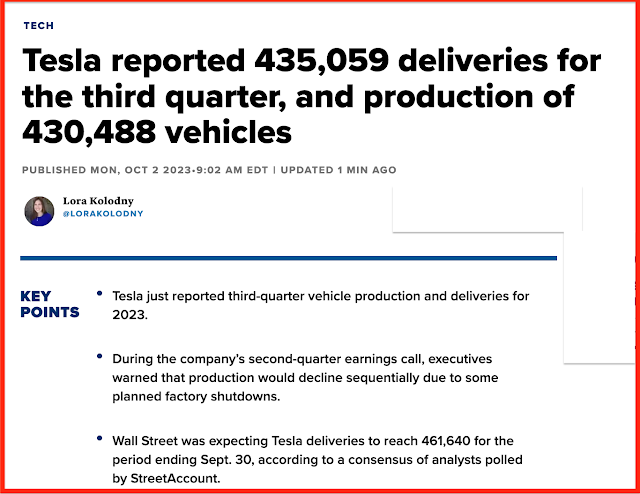Locator: 45621B.
First things first: the other day I mentioned that Barron's seemed to be down. It is / was not down. Like many other sites, Firefox can no longer access Barron's. At least on my Apple laptop. Firefox cannot access most NDIC webpages either.
Best NFL game over the weekend: on so many levels -- Chiefs vs Jets. On First Take, this game took priority over the Bills, Dolphins, and Dallas.
Nobel: prizes go to two scientists for mRNA vaccines. Link here.
Strike: apparently UAW and Mack reach agreement. Link here.
Saudi budget deficit: despite higher prices. Link here and here. And, here.
Saudi
Arabia has lowered its growth forecast and expects to post a budget
deficit this year rather than an earlier projected surplus, a
preliminary budget statement showed on Saturday.
The
largest Arab economy expects real gross domestic product to grow by
0.03% this year, the document released by the ministry of finance
showed, compared with a previous forecast for growth of 3.1%.
The document projected a budget deficit of 2% of GDP, compared with an earlier projection for a 0.4% surplus.
Total revenue is now expected to be 1.180 trillion riyals ($314.64 billion) and government spending is forecast to be 1.262 trillion riyals. An earlier projection put revenue this year at 1.130 trillion riyals and spending at 1.114 trillion riyals. Reuters.
The current price rally in oil will help the kingdom rake more money
in, with budget revenues seen at 1.18 trillion riyals, or $310 billion,
up from an earlier projection of 1.13 trillion riyals, or $300 billion.
Still, the updated revenue figure is substantially lower than last
year’s revenues, which came in at 1.268 trillion riyals, equal to about
$340 billion. Charles Kennedy.
Spending for the current financial year, meanwhile, has been revised upwards, widening the budget deficit gap.
The big story line for me: for how much influence Saudi Arabia has around the world, I had forgotten how incredibly small its annual budget was.
For the US: total revenue around $330 billion.
UAW strike, link here:
Friday, the UAW expanded its strike against the auto makers, the second expansion after walking out at three facilities, one at each auto maker, on Sept. 15.
“The UAW strike debacle continues in 313,” wrote Wedbush analyst Dan Ives, referencing the area code for Detroit. It’s “like watching a slow moving car crash.”
He estimates that the union’s demand can add $3,000 to $5,000 to the price of an electric vehicle manufactured by Ford (ticker: F), GM (GM), or Stellantis (STLA). That is an alarmingly high number. And it’s one that is likely too high.
Ford CEO Jim Farley didn’t completely discount the number when asked to comment on a Friday media call, pointing out that worst-case scenarios were based on the union’s initial demands, which include wage increases in the range of 40%, better retirement benefits, and a 32-hour work week (while still getting paid for 40 hours).
*************************
Back to the Bakken
WTI: $91.66.
Tuesday, October 3, 2023: 9 for the month; 9 for the quarter, 579 for the year
36961, conf, WPX, Nero 8-26H,
39458, conf, CLR, Arthur 4-12H,
38990, conf, Hess, RS-Harstad-155-91-0433H-6,
38272, conf, Hess, BB-Olson-LW-150-95-08H-1,
38038, conf, Petroshale, Tahu 4kTFH,
Monday, October 2, 2023: 4 for the month; 4 for the quarter, 574 for the year
39690, conf, WPX, Marcus 8-26H,
39459, conf, CLR, Arthur 12-5H1,
38033, conf, Petroshhale, Tahu 2MBH,
Sunday, October 1, 2023: 1 for the month; 1 for the quarter, 571 for the year
39360, conf, CLR, Hegler 3-13HSL1,
Saturday, September30, 2023: 123 for the month; 325 for the quarter, 570 for the year
39566, conf, Kraken, Cass 4-9 5H,
39460, conf, CLR, Hegler 4-13H,
38989, conf, Hess, RS-Harstad 155-91-0433H-6,
38835, conf, Enerplus, Hay Draw 148-97-27-34-3H, see these spectacular wells here;
RBN Energy: gas-focused producers' strong, profitable reserve growth tested by recent price plunge.
U.S. natural gas producers had a rough start to 2023, with spot
prices dipping to just above $2.15/MMBtu this past spring. But optimism
was abundant in midyear earnings calls on expectations that demand will
eventually soar, driven largely by a near-doubling of U.S. LNG export
capacity by the end of the decade. A key question, however, is whether
E&Ps have built the inventories of proved reserves to support future
production increases to meet that demand. In today’s RBN blog, we
analyze the crucial issue of reserve replacement by the major U.S.
Gas-Weighted E&Ps.
Before we began this four-part series, we asked, “How much longer can shale support U.S. oil and gas production?” In Say You’ll be There,
we said that Energy Information Administration (EIA) estimates of
proved reserves, which are assumed to have at least a 90% chance of
eventual recovery under existing economic and operating conditions,
imply about 10 years of remaining volumes of crude oil and condensate
and 10-17 years of natural gas in the major producing basins. Critical
to maintaining or expanding these inventories is the rate at which U.S.
producers are replacing the reserves they produce. Equally important —
especially in an era of heightened scrutiny over capital efficiency — is
the price paid to achieve that replacement rate.
















